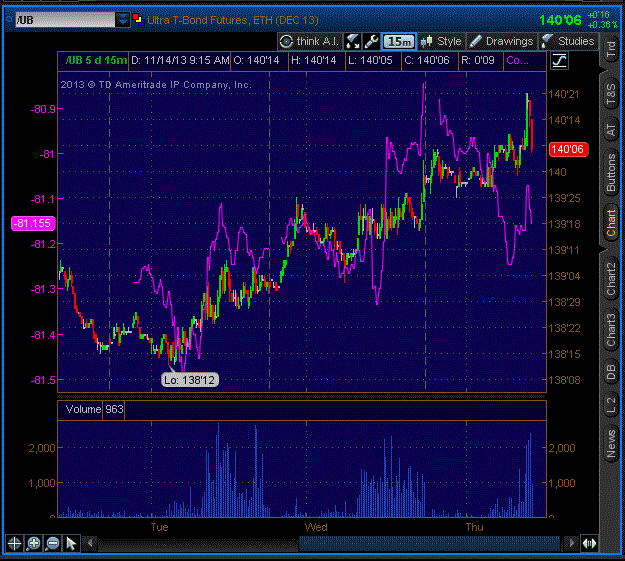It would appear that much of the rally yesterday (and early overnight) was driven by hope (and confirmed relief) that Fed chair nominee Yellen is not about to take on a substantially less-dovish tone in today’s testimony in an effort to garner the support of the more hawkish elements of the Senate Banking Committee. There was a great deal of confirmation bias in the market’s move and interpretation but, as BofAML notes below, this may be misplaced. The more important part of today’s testimony is yet to come in the Q&A session – where we will hear likely more unscripted thoughts from the QEeen at her Senate confirmation this morning.
Deutsche’s Jim Reid notes that:
The market has zeroed in on the 5th and 6th paragraphs of the statement where Yellen describes the economy as performing “far short” of its potential. She goes on to say that inflation has been running below target and that unemployment is still too high. As such, Yellen concludes that the Fed will continue to use monetary policy tools to promote a more robust recovery.
On the question of QE, Yellen says that a strong recovery will enable the Fed to reduce its monetary accommodation and reliance on unconventional policy tools. She adds that supporting the recovery is the “surest path to returning to a more normal” approach to monetary policy.
So while the tones are certainly dovish, it’s impossible to infer precise policy thoughts from her remarks. She clearly views that the economy has not yet reached a strong enough trajectory but is she making a grander point that they won’t start tapering until the data is better than now?
Or does tapering to $70bn, $50bn, $30bn etc a month still represent supporting the recovery. Indeed, it’s difficult to infer anything concrete regarding the path of monetary policy from Yellen’s prepared comments.
So while dovish, he implies that perhaps the market is experiencing a little to much confirmation bias.
BofAML also notes that markets read her comments as dovish, inferring that she might wait some time to taper Fed asset purchases… but disagree with that interpretation.
Markets see prepared statement as dovish
Janet Yellen, the current vice chair of the Federal Reserve and nominee to replace Ben Bernanke as Fed chair, released a brief prepared statement (see full report for footnote) Wednesday afternoon, ahead of the Senate Banking Committee hearing that begins at 10 AM ET on Thursday, November 14. Markets read it as dovish, particularly as many commentators expected her to retreat to a “balanced” (i.e., more hawkish) position. We view her comments as supporting continued Fed accommodation, consistent with ongoing official FOMC statements but not revealing any specific policy plans. Overall we expect continuity in Fed policy following her confirmation.
Support for dual mandate and inflation target
No surprise, Yellen’s text confirms she strongly supports the Fed’s dual mandate. She acknowledges progress in the recovery (to push back against the inevitable suggestion on Thursday that Fed easing has been ineffective), but notes unemployment is “still too high” while inflation may remain below the Fed’s 2% goal for some time. Hence, she concludes, the Fed “has more work to do.” To front-run questions that presume she will be too soft on inflation, Yellen notes that she “led the effort to adopt … a 2% goal for inflation.” This, she argues, sends a “clear and powerful message” that “has helped anchor the public’s expectations” for “low and stable” inflation. Expect her to repeat this argument multiple times on Thursday.
The taper question, ultimately
Yellen states that “supporting the recovery today is the surest path to a more normal approach to monetary policy” – in other words, policy needs to remain easy now to tighten later. Additionally, “a strong recovery will ultimately enable the Fed to reduce its monetary accommodation and reliance on unconventional policy tools such as asset purchases.” Early commentary focused on the word “ultimately” as a possible signal that Yellen does not plan to taper for a while.
But “reduce its monetary accommodation” typically has meant rate hikes in official Fed communication, while reducing “reliance on unconventional tools” likely refers to the eventual reduction in the size of the Fed’s balance sheet rather than tapering. Recall, most Fed officials take a “stock approach” to QE; in that view it’s the total amount of assets owned and not the purchase pace that defines the degree of accommodation. No doubt she’ll get questions about the Fed’s tapering plans on Thursday.
On financial stability
Yellen further pledges to continue to support Fed efforts to address financial stability concerns. She emphasizes supervisory and regulatory tools “to reduce the threat of another financial crisis,” but notes that the Fed also is taking financial stability “into consideration when carrying out its responsibilities for monetary policy.” This suggests she may be open to tightening policy to address bubble concerns. Look for her to be questioned on whether there are bubbles now (expected answer: no, or at least not systemic) and how the Fed should respond to such risks.
One thing appears clear – QEeen Yellen will bring continuity to Fed policy once she is confirmed… but a taper may still be on the table.







via Zero Hedge http://feedproxy.google.com/~r/zerohedge/feed/~3/y3TfcPsxc2k/story01.htm Tyler Durden
![]()










